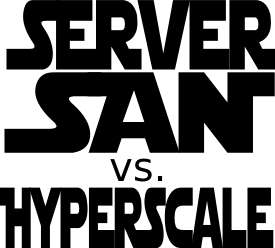 NEWS
NEWS
 NEWS
NEWS
 NEWS
NEWS
![]() Server SAN is a cost effective method of pooling compute and storage that is managed via a single software-defined interface. It can enable enterprises to effectively tear down silos and operate in an environment where processes are automated and technology is converged. Still, there are numerous competing technologies, including hyperscale storage. What advantages does Server SAN have over hyperscale and how can it deliver results for enterprises where hyperscale cannot?
Server SAN is a cost effective method of pooling compute and storage that is managed via a single software-defined interface. It can enable enterprises to effectively tear down silos and operate in an environment where processes are automated and technology is converged. Still, there are numerous competing technologies, including hyperscale storage. What advantages does Server SAN have over hyperscale and how can it deliver results for enterprises where hyperscale cannot?
Many mega corporations have employed hyperscale storage for their incredibly large amounts of data. Hyperscale operates on a larger magnitude of storage than conventional enterprise storage, dealing in petabytes rather than terabytes. Because of this Google, Amazon, Facebook and possibly others have adopted it for local distributed storage. It is designed to be software-defined with minimal features, without the redundancy that you would find in traditional enterprise storage. It relies on fail-over workload rather than redundancy.
When designed well, hyperscale compute with direct-attached storage (DAS) can greatly reduce the need to spend money on dedicated storage devices. To accomplish that design, however, it takes a good deal of complex engineering, something large cloud companies like Facebook and Google have internally developed for their unique infrastructures.
For the average enterprise that is not as massive as Facebook or Google, a more manageable storage solution is necessary. Server SAN still offers the cost effectiveness of hyperscale without the complexity. It offers distributed storage while still providing a good base for flexible application functionality. To be simple and yet still scalable is the promise of Server SAN.
According to Wikibon analyst Stu Miniman, Hyperscale is too massive an undertaking for the average enterprise, but Server SAN may be a feasible alternative. “There are only about 20 companies in the world that can truly do hyperscale – buying at massive quantities and using advanced skills (often a team of PhDs) to design the environment. Enterprise data centers and even most service providers can’t do those things – Server SAN is a good architecture for them to look at for certain applications,” he explained.
Unlike other software-defined storage options, Server SAN includes compute as part of the configuration. It is seamlessly integrated and eliminates the need to manually add or remove drives or nodes as your business expands or scales down. It is less expensive than traditional networked storage and also reduces network overhead since the storage is closer to the CPU. This also makes it faster and more flexible than cloud storage.
Server SAN is a great option for hosting multiple applications, and it is flexible enough to meet the demands of changing enterprise environments. Unless you are running something as big as Google Apps, Server SAN is probably a better choice over Hyperscale in the long term.
THANK YOU